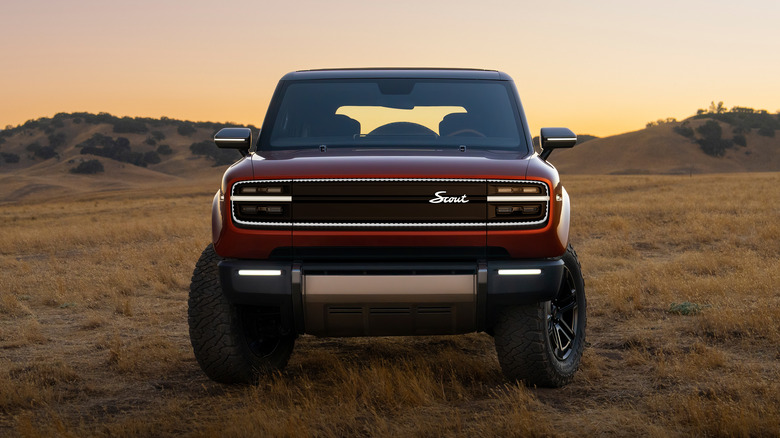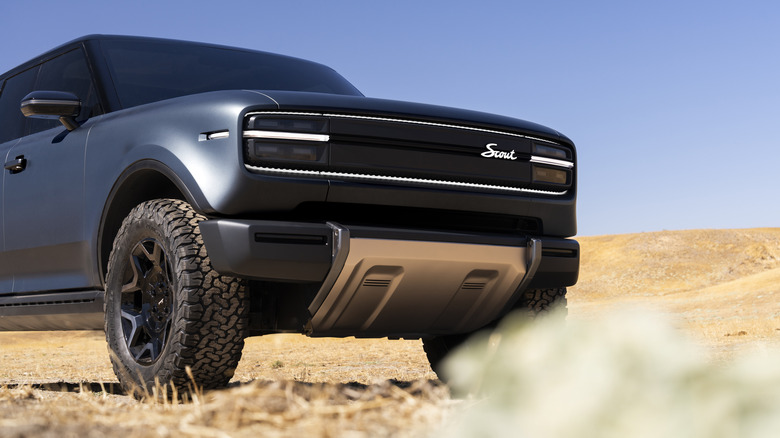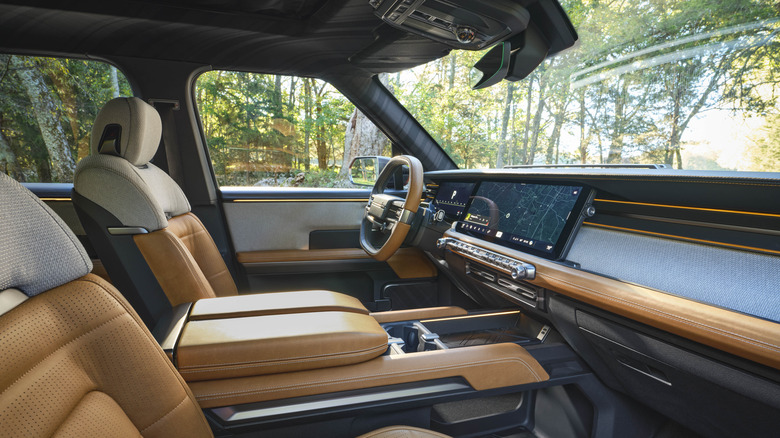Scout's New Trucks May Look Like A Rivian, But Here's Why You Shouldn't Be Fooled
The Scout is back as an EV, and we can rejoice that there is another huge boxy EV on the horizon. Observers may, however, notice some visual quirks with the new nostalgia-soaked Scout; it kind of looks like a Rivian R1T or R1S. The visual similarities are certainly there, but how Scout's trucks actually function couldn't be more different from Rivian's EVs.
On a technical end, the Rivian twins are powerhouses, but both are constructed in a way that isn't a lot different compared to other EVs and modern cars in general. Although it skirts traditional definitions, it's generally considered a hybrid unibody/body-on-frame design: rather than completely separating the frame from the cab and bed, as in a traditional body-on-frame truck like an F-150, the underlying skateboard (with the battery pack and electric motors) is more tightly bonded to the upper body for improvements in rigidity and load-sharing.
It isn't necessarily a bad thing that Rivian doesn't take notes from more conventional truck makers, as Rivians are certainly popular. Its EV layout just isn't the most accommodating to mechanical components that appeal to hard-core off-roaders or overlanders. However, the Scout marches to a different architectural drummer that might get people a little more excited.
Mechanical advantages of the next-gen Scouts
In a move that was surprising to some (me included), the EV Scout is a body-on-frame design, like a traditional truck or off-roader like the Jeep Wrangler or Ford Bronco. The body-on-frame structure can get people worked up just on mention alone, as it has real benefits to off-roading. It also helps that Scout Motors decided to give the new EV all manner of mechanical goodies.
The Scout is fitted with a solid rear-axle that, while not giving a lot of benefits to pavement-based driving, offers a lot of durability for smashing over rocks and dirt. It's a significantly more robust way of delivering power to the rear end of the car compared to an independent suspension setup.
Off-road fans will also rejoice in the announcement that the Scout will feature front and rear mechanical differential lockers. Lockers allow the driver to lock either set of wheels to spin — and therefore deliver power — at the same speed, which provides more traction in difficult off-roading environments. Again, you wouldn't use a locking differential during a commute, but it can be a lifesaver in the snow, sand, or mud. Disconnecting sway bars that give you more wheel travel round out Scout's off-roading mechanical advantages as well.
Rejoice at the inclusion of tactile buttons
Further distinguishing itself from Rivian, the Scout EVs will also feature a load of mechanical buttons within the interior over the touchscreen-centric layout that a lot of EVs opt for. To some, buttons may not be much of a selling point. However, when you're rock-crawling and you need to lock the differential, throw on hazard lights, or otherwise change drive modes, a physical button to get a hold on is miles more convenient than navigating through an infotainment system — especially if your hands are sandy, cold, gloved, or otherwise less than squeaky clean.
The exterior isn't the most exciting EV to come out in recent years, but the mechanical bits and pieces that comprise the new EV Scout show that Scout Motors seems to have spent more time and effort working on what off-roaders actually care about. You aren't going to care what your truck looks like when it's covered in mud and inching up the side of a ravine, and Scout understands that.


